| Note: If you see this text you use a browser which does not support usual Web-standards. Therefore the design of Media Art Net will not display correctly. Contents are nevertheless provided. For greatest possible comfort and full functionality you should use one of the recommended browsers. |
![]() Editorial
Editorial
Art and Cinematography![]() Gregor Stemmrich
Gregor Stemmrich
Cinema and art are one of those double acts, which provoke endless bad seminars, dull conferences and boring exhibitions based on art and something similar. [more]![]()
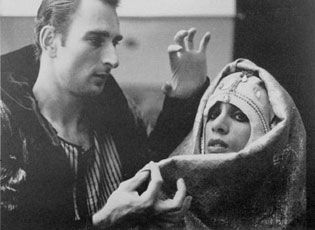 | Artists, Auteurs, and Star. On the Human Factor in the Culture Industry The auteur was perhaps the last model of an artist from the old Europe standing specifically for cinema as an art. The idea behind the term was that it was still possible to maintain individual handwriting and that the individual-responsible proportion of a film was the crucial, i.e. artistic element, even when dealing with a gigantic economical, technical and hierarchical-social apparatus. The cinema could only fall into the category of art at the price of an idea of authorship. [more] |
»That's the Only Now I Get« Immersion and Participation in Video Installations by Dan Graham, Steve McQueen, Douglas Gordon, Doug Aitken, Eija-Liisa Ahtila, Sam Taylor-Wood Film is taken back to its basic structures and subjected to critical analysis a hundred years after the medium was born. Contemporary artists are now addressing the history of the cinema's impact. Its technical devices have become cultural constants within our receptive behaviour. They include the darkened auditorium with its ‹cinematic quality›, the narrative standard that captures the narrative flow in pictorial sequences. and film editing, without whose visible montage technique the illusion of being ‹true to life› would not be possible. Here cinema and film are not interesting primarily as a genre, but as a stock of visual raw material. Two general tendencies can be identified among the many working approaches. [more] | 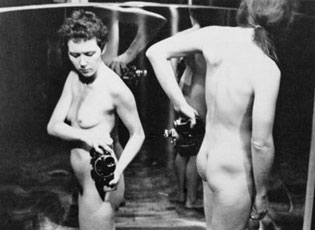 |
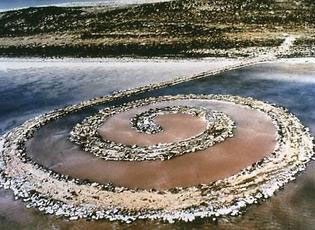 | Deserts of the Political - Michelangelo Antonioni, Robert Smithson and Michael Snow The desert boomed in the years around 1970. And not just because images of the desolate surface of the moon recorded the existence of a new desert. It was more because the colonization of the extraterrestrial desert was accompanied by the terrestrial deserts impacting emphatically on the imaginings of a global popular culture. In the late 1960s the desert became the construction site for spectacular earth works that artists like Robert Smithson carried out, preferably in the deserts of California, Nevada and Utah. [more] |
Toward a Corporeal Cinema: Theatricality in the \'70s Akerman's visit to the USA in the early 1970s put her in touch with the experimental cinema, Minimal Art, new American dance and performance art. The camera in »Hotel Monterey« and »News from Home« represents a variant on structural minimalism. Akerman's narrative film art presents a cinema of indifference. The relationship between spiritual contemplation and theatricality sustained in »Jeanne Dielmann«, »Je tu il elle« and »Les Rendez-vous d'Anna« indicates a desire to use performance as a means of experiencing the choice between turning one's face towards the scene or turning to the audience. [more] | 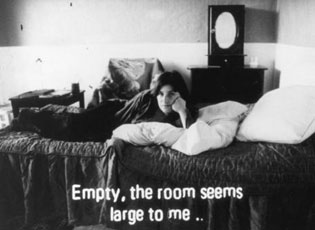 |
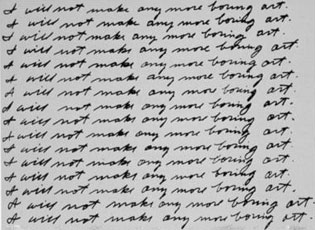 | No More Boring Art For artists of John Baldessari's generation, being professional had a great deal to do with education. Technical skills were a stigma, but wit was a plus. Baldessari's decision to work with Super-8 marked an unmistakable departure from both technology and mysticism. As the minimal events in his films are played out in real time, this is a recipe for boredom. In contrast with his films, Baldessari typically constructs his photographic work on the montage principle. He uses stills from films or television as his raw material. Precisely what is to be seen in the individual shots is left to chance. [more] |
The museum of attractions: Marcel Broodthaers and the section cinéma For Marcel Broodthaers, film functioned as strange tool for writing and deleting simultaneously. Broodthaers' own film work is in a state of permanent contradiction between the still and the moving image. It presents a text that is in the process of being written and at the same time has already been written. A text that keeps the present moving and yet at the same time records itself as part of the past. A film theater designed by Broodthaers himself is to be examined in order to understand the unique temporal quality of this cinematic method: the »Section Cinéma«, the seventh department in his famous fictitious museum, the »Musée d'Art Moderne, Département des Aigles«. [more] | 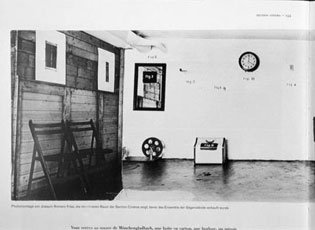 |
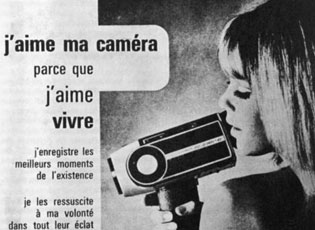 | Dismantling the Spectacle: The cinema of Guy Debord »Ciné qua non«: Guy Debord and Filmic Practice as Theory The artist and theoretician Guy Debord formulated a radical critique of society in the 1960s with his theses about the »society of spectacle«. The term spectacle is used to criticize socio-economic conditions (e.g. alienation) as conveyed by images from the mass media (cinema and television). Debord is a leading member of the Situationist Internationale (SI), which adopted an ambivalent attitude towards the cinema in the first issue (1958) of its magazine Internationale situationiste (IS). On the one hand, it insisted that the existing cinema should be destroyed. But then strategies were developed, e.g. use for another purpose (détournement), which was deployed to reinterpret entire films, by adding a new soundtrack, for example. [more] |
Le Détroit - An Experience rich in halftones In «Le Détroit» Stan Douglas stages a horror story that is both banal and complex. He successfully builds up and reinforces the eerie aspects of the film with powerful camera angles, the nocturnal, lonely scenery and an unnerving soundtrack using exterior noises and the sounds of movement. At the same time he deconstructs the components that have come down to us through literature, film and television to make everyday things seem eerie and strange. Douglas's film is based both on his research into Detroit, which he captured in a series of photographs, and «The Haunting of Hill House», an occult ghost story by Shirley Jackson published in 1959. For this venture, Douglas constructed a complicated installation using two film projectors set up opposite each other. [more] | 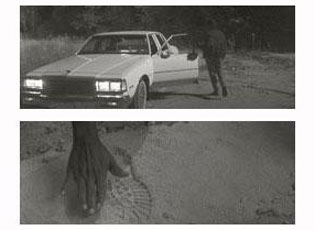 |
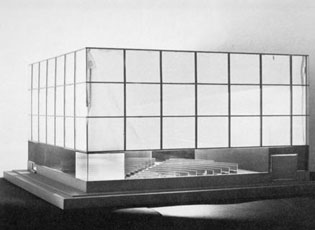 | Dan Graham's «cinema» and film theory Dan Graham's «Cinema» (1981) still exists only as an architectural model. It was conceived as an abstract hypothesis and a concrete empirical model in one. It represents a definite departure from normal cinema architecture in that it sets out to make the psychological effect of the cinema experience transparent-literally-to the audience. But this means that it is also suitable for relating cinema theory concepts of the kind that have developed since the early 1970s to the particular features of its architecture. [more] |
Acousmêtrie - On the Relationship between Voice and Image in the Films of Chris Marker Chris Marker himself is often quoted with a remark from «Sans soleil,» made by the character of Yamaneko, the computer expert: images simply want to be what they are, «that is, pictures.» [more] | 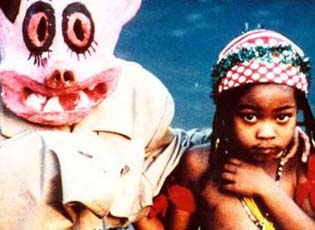 |
 | «Riddles of the Sphinx». The Work of Laura Mulvey and Peter Wollen: Between Counter-Strategy and Deconstruction Laura Mulvey's and Peter Wollen's theoretical writings did not simply formulate elaborate analyses and critiques of film and art in a restricted sense, or of politics and culture in a wider one. They were also part of a «social movement» in England that was setting its sights on a new kind of textual production and practice, in the spirit of the 70s and influenced by post-structuralist theories from France (Barthes, Derrida, Lacan). But while in France the concept of deconstruction caught on for strategies that try to undermine the classical distinction between text and commentary, Mulvey and Wollen hung on to the »Counter-Strategy« concept. [more] |
Of Gerbils and Men: Politics, Satire and Passion in Some Films of Joyce Wieland Although Canadian artist Joyce Wieland was one of only very few women in the 1960s to venture into the field of film (and particularly structural film), her films have been the subject of surprising little substantive critical attention in recent years. The following text argues that the reasons for such neglect reside in the films themselves, which self-consciously broach the line designated by Peter Wollen in his seminal »The Two Avant-Gardes« insisting on the wisdom of the space between the two options. [more] |  |